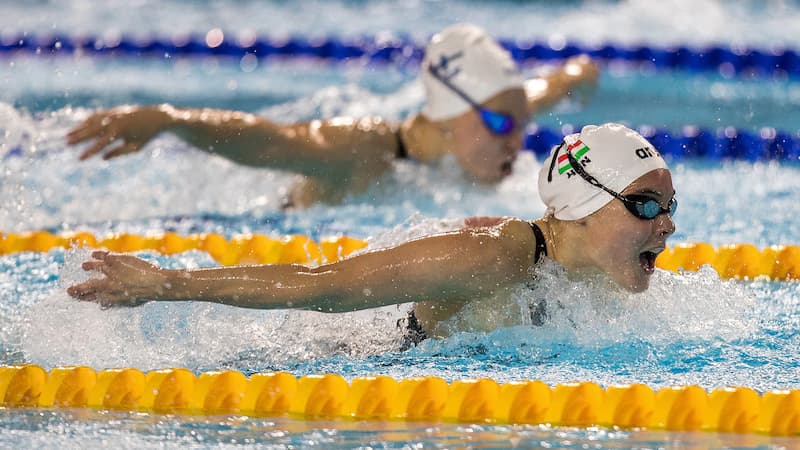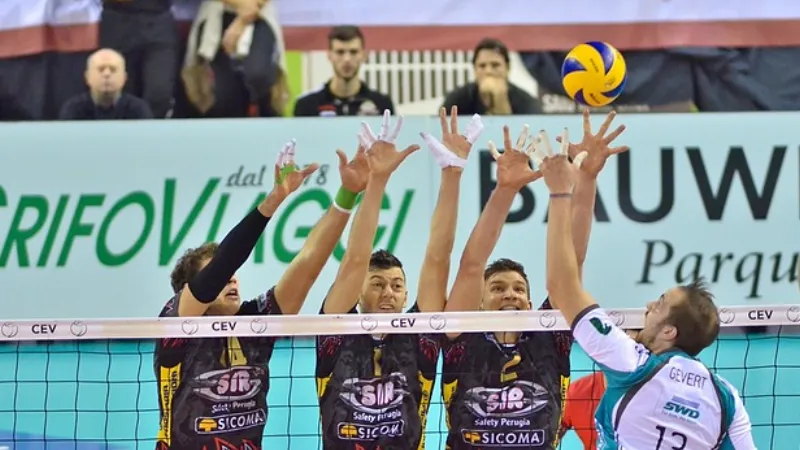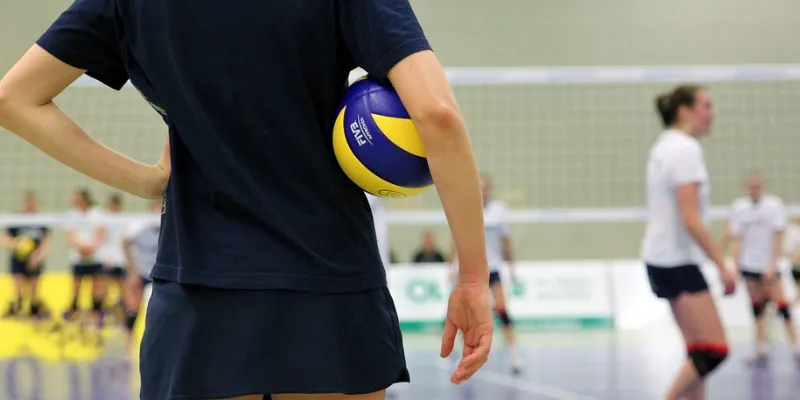What Is A Medley In Swimming? Basic Definition & Individual Medley

Medley is a combination of four different swimming styles—backstroke, breaststroke, butterfly, and freestyle—into one race. This race is either swum by one swimmer as individual medley (IM) or by four swimmers as a medley relay.
Please read on for more information about what a medley in swimming is as I give you more specific examples.
Table of Contents
Medley Swimming History
Before the butterfly was established as an individual stroke in 1952, individual medley races comprised of just three strokes and were typically swum over three or six lengths.
One of the first uses of the butterfly arm technique was made by Henry Myers, who used an overarm recovery for the entirety of his opening breaststroke leg in a 150 yard individual medley race that was at the time known as a “three-stroke medley.”
The 1950s saw the addition of a butterfly leg to individual medley races, which were then conducted in the order of butterfly, backstroke, breaststroke, and freestyle.
In contrast to individual freestyle events, an individual medley race’s freestyle portion does not allow for the swimming of butterfly, backstroke, or breaststroke.
At the 2015 World Championships in Kazan, American Ryan Lochte used a backstroke dolphin kick off the wall for his freestyle leg before turning to surface on his front and swimming front crawl for the remainder of the distance to win the 200-meter individual medley event for the fourth time in a row.
Although Lochte was not disqualified at the Championships, the world’s swimming governing body FINA responded by declaring the maneuver would be prohibited at future competitions because the American was technically beginning the leg by swimming backstroke, regardless of whether he was under or on the surface of the water.
Individual Medley
A race in which the total distance is divided into either four equal portions, with each swimmer using the butterfly stroke for the first portion before using the other strokes to follow the same pattern as in the three-part medley, or the total distance is divided into three equal portions, with each swimmer using the backstroke for the first portion, the breaststroke for the second portion, and the freestyle for the third.
Individual Medley: The Olympic Games
Only the individual medley competitions at the Olympic Games have historically featured races over equal distances for men and women.
Since the Tokyo Olympics in 1964, a 400m Individual Medley has taken place at every Games, while the men’s and women’s 200m Individual Medley competitions first appeared in 1968 and 1972, respectively, and have been held at every Games since 1984.
A 100m Individual Medley race is held at short course events, where competitors swim one 25m length of each stroke, even though Olympic individual medley races are only held over 200m and 400m.
Why Do You Need To Practice IM?
- Increasing Your Water Feel: Your muscles are worked differently and various energy systems are activated during each stroke. You will become a faster swimmer overall if you swim IM, even if you only compete in freestyle races.
- Burns More Calories: You’ll burn more calories during each workout if you use your muscles in novel ways and mobilize all of your energy sources!
- Prevent Injury: Your risk of developing overuse injuries in your shoulders and other body parts is decreased by IM, which breaks up repetitive movements.
- More Fun/Mix It Up: The same-stroke swimming can become monotonous. IM adds variety and keeps your workouts engaging.
Different Types Of “IM” Training
Several ways exist for integrating IM into your workouts. These are the top five variations. Visit our support site for a glossary of additional terms.
“IM Order:” By doing one rep of each stroke, you can finish the set. For instance, if your set was a 4×50 IM order, you would swim as follows:
- 50 Butterfly
- 50 Backstroke
- 50 Breaststroke
- 50 Freestyle
“FRIM:” This stands for “Freestyle IM,” which means you will swim freestyle rather than butterfly. This variation makes your IM sets more aerobic and enables you to start the backstroke and breaststroke from scratch. As an example of a 100 FRIM:
- 25 Freestyle
- 25 Backstroke
- 25 Breaststroke
- 25 Freestyle
“Transition IM:” With transition IM, you can lower your training load while improving your turns by varying your strokes. For instance, a set of 3 x 50s Transition IM would appear as follows:
- 1st 50: 25 Butterfly, 25 Backstroke
- 2nd 50: 25 Backstroke, 25 Breaststroke
- 3rd 50: 25 Breaststroke, 25 Freestyle
“Twitch, IM/FREE, or Major Stroke/Free:” IM order and Freestyle will be alternated here. The swim stroke pattern for a 200 Twitch would be as follows:
- 25 Butterfly, 25 Freestyle
- 25 Backstroke, 25 Freestyle
- 25 Breaststroke, 25 Freestyle
- 25 Freestyle, 25 Freestyle
IM Order x2 or x3: You will perform each stroke in this setup numerous times in IM order. For every repetition, you can vary the speed or effort. The following would be done if your set was 8x25s IM Order x2 (odds easy/evens fast):
- 2×25 Butterfly 1 easy/1 fast
- 2×25 Backstroke 1 easy/1 fast
- 2×25 Breaststroke 1 easy/1 fast
- 2×25 Freestyle 1 easy/1 fast

Medley Relay
In a medley relay, four different swimmers compete using one stroke each.
Stroke Order
Four different swimmers participate in the medley relay, each swimming one of the four strokes. Because backstroke is started from the water, it is the first event. If backstroke wasn’t the first event, the starting backstroke swimmer and the finishing previous swimmer could collide. With breaststroke being the slowest and freestyle being the fastest, the remaining strokes are arranged in order of speed. The strokes are applied in the following order:
- Backstroke
- Breaststroke
- Butterfly
- Freestyle is defined as any swimming style other than the backstroke, breaststroke, and butterfly.
Competitions
Both men and women regularly compete in medley relay events.
- 4*50 Swum only on the 25m short lane for the Medley Relay. This is not an Olympic competition
- 4*100 Medley Relay: Swum on both the 25-meter and 50-meter lanes. Since Rome, Italy hosted the 1960 Summer Olympics, this was the first Olympic medley competition. It should be noted that the first Olympic butterfly competition was held at the 1956 Summer Olympics.
Technique
The technique for medley relay events doesn’t differ significantly from the technique for the individual events for the four strokes. The first swimmer performs a standard 50- or 100-meter backstroke. The subsequent swimmer’s start is signaled by the previous swimmer finishing their turn by touching the wall, which is the only difference between them and the previous swimmer. It’s also crucial to remember that freestyle for medley events refers to any style other than backstroke, breaststroke, or butterfly.
Benefits Of Medley In Swimming
Avoid Repetitive Strain Injuries
Your best swimming or triathlon season could be ruined by repetitive strain injuries if you swim with the same stroke all the time, which is typically freestyle for triathletes. By varying the strokes, you can use various muscles and motions to support the health of your muscles and shoulders. For working your hamstrings and chest muscles, breaststroke is a particularly effective exercise. Since you need to use more muscles when backstroke to maintain a straight back in the water, it can help you posture. Your hip flexibility may also be enhanced. When swimming butterfly, your core muscles must work harder to keep your body stable as both your arms and legs are in motion at once. To raise both of your arms out of the water and above your head, you must also use your arm, chest, and upper back muscles. The butterfly exercise’s body position also enhances general flexibility. Let’s begin our six-week butterfly course by learning about butterflies.
Increase The Intensity Of Your Training
Throwing in additional strokes and/or an individual medley or two is the best way to intensify your training. If you think about it, swimming 100 meters freestyle is a walk in the park that can be easily repeated endlessly. A 100-meter butterfly feels like a small death and is worth five times a 100-meter freestyle. The intensity rises when using different swimming strokes. Why is that so? Every stroke involves a unique combination of breathing patterns, muscle movements, power intensities, and body positions, keeping us on our toes while also requiring a variety of skills. This is difficult when you’re powering out of the water and breathing to the front in the butterfly and breaststroke. Last but not least is the freestyle, which is already challenging enough with our faces in the water most of the time. Being on our backs while remembering to breathe is a challenge in the backstroke.
Similar to an individual medley, open water swimming can have variable conditions and intensity. Make us proud by trying it out and succeeding.
New Skill Aquisition Is More Body Awareness
The development of muscles, breath control, and body coordination will all be enhanced by learning another stroke. Each stroke calls for a distinct level of control over our bodies and minds. Here are the reasons why the other strokes enhance our freestyle.
The in-sweep in breaststroke simulates the catch. You can improve your body position in freestyle by streamlining your body at the conclusion of each stroke cycle.
You’ll succeed with the aid of the butterfly. Your hands will follow the ideal path for a strong pull through because there is no rotation of the body and your arms pull through simultaneously, which enhances this advantageous aspect of the freestyle. When swimming butterfly, a strong push out is developed that will serve you well in the freestyle.
Backstroke will maintain the flexibility of your spine and teach you how to rotate your body well. You can easily copy and paste the still head position needed for backstroke into your freestyle.
There are plenty of good reasons to mix things up next to you in the pool.
FAQs
Which Stroke Comes First in the Medley Relay?
Four swimmers compete in the medley relay, using various strokes. The first swimmer swims Backstroke (BA), the second Breaststroke
(BR), the third Butterfly
(FL), and the fourth Freestyle
(The following is a simple way to remember this: BA, BR, FL, and FR are listed in alphabetical order.
Can You Swim Medley in Any Order?
Backstroke, breaststroke, butterfly, and freestyle are performed in the relay medley in that order.In the individual medley, the order goes butterfly, backstroke, breaststroke then freestyle. The logic behind the orders is a little hazy, but they remain constant.
Final Words
The post focused on the definition of a medley in swimming. Did you now have a thorough understanding of swimming medleys after reading the entire post?
Again, if you’re interested in learning more about swimming, check out our posts. Please leave a comment if you have any questions about what a medley in swimming is.
I appreciate your reading.







